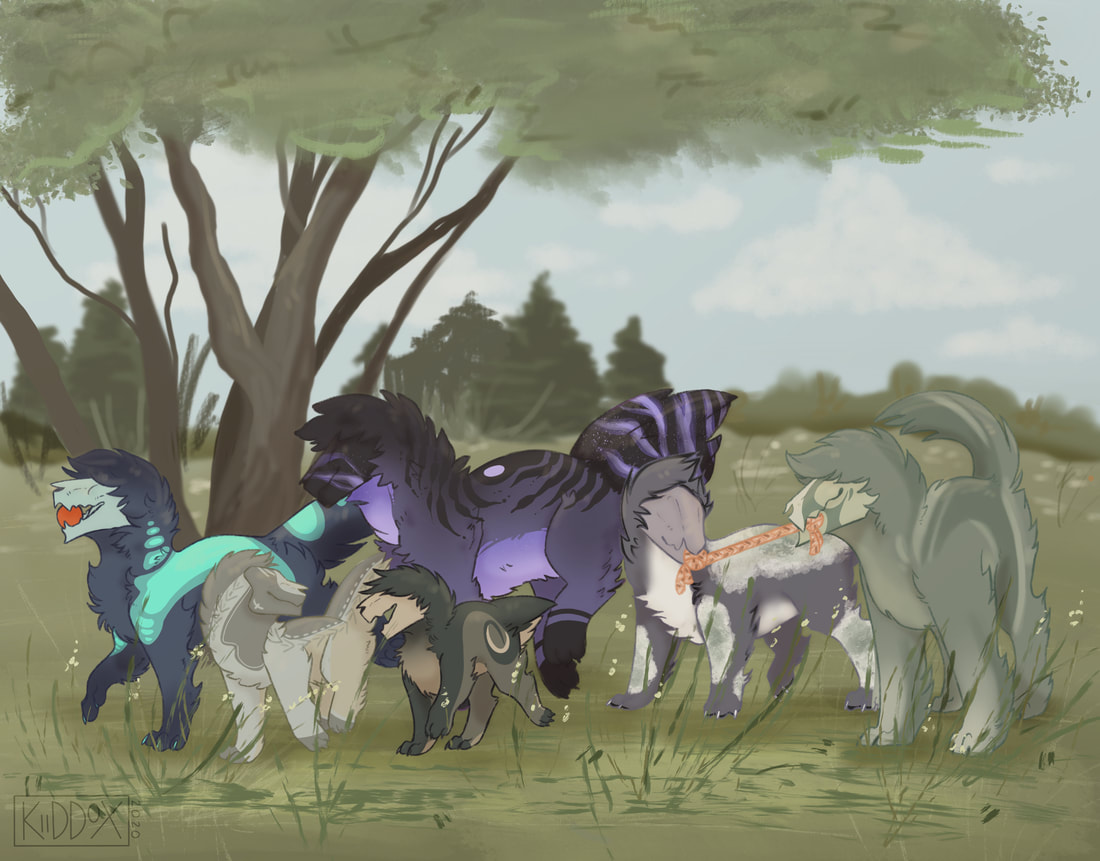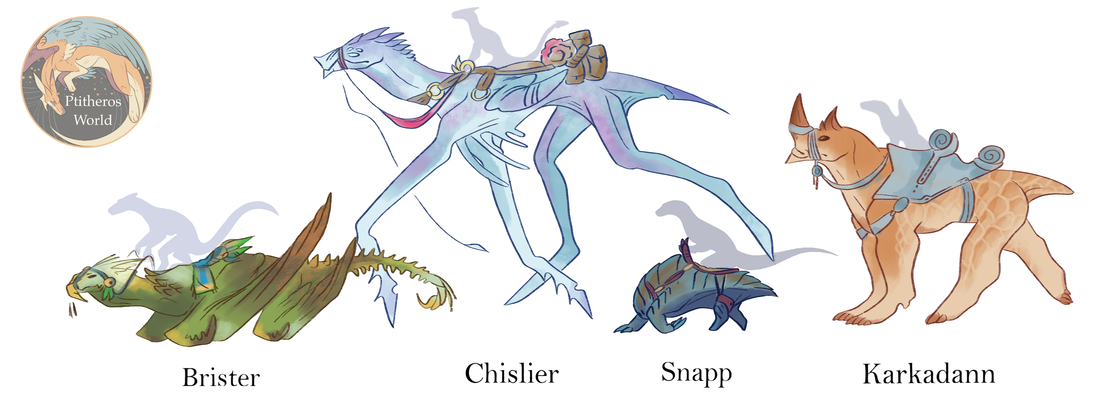TION

Tions were originally domesticated to be hunting partners. They are carnivores that can survive in a large range of climates and housing situations. A tion has to be adjusted to living with a Ptithian from a young age so they can associate their master as the leader of their "pack", making them naturally loyal and protective over them. In the past, a tion pup would be taken from a wild mother and raised manually. Nowadays, it's easier to get a pup from a breeder or shelter, which are places that tions who have been domesticated for generations can be found. These tions/tion pups are more docile and easier to train. A tion has to be fed a diet of meat and some grain, need ample space to run, and require attention from their master due to their pack instincts. A tion separated from a pack (their master or master's family) get horrible separation anxiety.
FEN

Fens are the "cats" of Ptitheros. These small carnivores live in warm enviorments and hunt pests. They were naturally domesticated by adapting to city and town life, making them constantly live near Ptithians. They got used to them and became fearless of them, causing them to enter homes and buildings. Nowadays fens are kept as pets by Ptithians, even though most fens couldn't care less about a Ptithian giving them free food and a bed. Most fens do not take orders and are not helpful like a tion can be.
BALUU

Baluus are small amphibians that can be found as pets in wet or forest-y locations. They are low-to-the-ground creatures, slow, don't eat much, and can follow very simple commands if taught correctly. They enjoy the presence of Ptithians and like to, very slowly, follow their master around the house. Baluus have a unique ability that can make them useful in certain situations and professions. Called the "walking backpack" for a reason; a baluu can eat anything and store it in what seems to be a black hole in their stomach. Scientifically it's just an ever-stretching organ attached to their stomach. Any item can be put in there, so for an explorer, they can feed their baluu most of their supplies, then just bring the baluu with them.
FAELLER

Faellers are avian carnivores that usually stay away from Ptithians. However, a form of falconry exists in Ptitheros. Faellers can be raised from an egg and trained using food to catch prey or watch over locations for their handlers. Unlike other companions, faellers are not fully domesticated and have an agenda of their own if they choose so. A faeller who feels bored or poorly taken care off will leave the first chance they get. A faeller being loyal to a handler is rare, they are merely useful so long as they get their fair share.
Mounts

Despite Ptithians being very strong, able-bodied, and often flight-capable creatures, even they prefer to use the might of other animals to lessen their burdens. Many different creatures have been domesticated to some capacity over the years, but some have been assigned a common role known as Mount Companions. These companions are able to be ridden and usually can carry some cargo with them.
Brirster
Brirsters were domesticated by one of the early groups of Sequ'Manko. These creatures were once feared monsters, for they are carnivorous and are able to glide through the dense jungle trees with as much ease a jungle-raised dragon. Evolved from the same plant-based Animalia family as the infamous briar, the brirster has skin made of fleshy bark and a top side covered in grass. Durable, long-fingered, brief flight capable wings, and a flattened body. Brirsters are able to carry low amounts of cargo and are used to transport things through the jungle or other tree-heavy areas that other mounts cannot reach as often. Brirsters are essential to sustaining forts and posts set up in places in like Dark Briar Grove. Brirsters are rode on their shoulders, making them singular-person mounts, so most are used for personal transport or cavalry defense by the Mankians back when their kingdom stood strong. Brirsters can be used as low-weight cargo mounts, personal mounts, emergency rescue mounts, and cavalry mounts.
Chislier
Chisliers were domesticated by those who lived on the edges of the Ulhar Caesin. These creatures are migratory, tall-standing, and docile. Those who tamed them did so in order to make use of their height, size, and speed. Able to run quickly on their lanky legs for short bursts, chisliers can carry light cargo and transport such from place to place at a adequate pace even with only one at disposal. Chisliers became popular all across the southern coastline, for the flat beaches and swamps with rising tides made land-travel with basic wheels difficult. The endless legs of the chiseler made water or dense vegetation no longer a problem. Chisliers are very docile and herd-oriented, making raising them often a family business of maintaining an entire herd. Chisliers removed from their herds for long amounts of time become stressed and less responsive to commands, eventually falling to the ground from heart failure due to anxiety. Chisliers can be used as trade cargo mounts, racing mounts, personal mounts, taxi mounts, patrol mounts, and therapy animals. Their thin legs make them capable of crossing through somewhat-dense cities if necessary but there are routes better suited for them.
Snapp
Snapps are one of the oldest domesticated species on Ptitheros, records of their use go back to the earliest eras but can be traced back to originally an animal from the Honeycomb Forest. It is likely the Chaverians domesticated the roly-poly beasts and have since distributed them across the continent through trade routes and transportation. Because of the snapps' unique defensive curling-up ability they became used as a form of biomechanical wheels for larger platforms. Early travelers figured out snapps could be trained to lift and carry wooden platforms that held many goods and roll up to travel much faster. More snapps added meant larger platforms, eventually leading to the large caravans and chariots that bring items and important individuals safely across vast landscapes. Snapps are also used as singular mounts for travelers and are able to pull their rider into their roll to protect their owner when something threatens them. Snapps can be used as building and caravan carries, cargo carries, personal mounts, taxi vehicles, and family pets.
Karkadann
Karkadanns were first domesticated by nomadic travelers out in the Meldra Desert in order to transport their dwellings and members. As these loose groups assimilated into the Tucruitorian cities over time these large beasts became used for merchants and messengers to cut time having to transport goods and mail. Karkadanns have not been changed much as domestication continued and tamed karkadanns can easily be released into the wild and will return to a feral state within a few years when lacking societal contact. Although a common sight when traveling desert roads or on the outer stables of Tucruitora and Solluhawh, karkadanns are still dangerous and must be treated with respect. With their massive size and high temperament, there is a track record of karkadanns piercing their owners with their horns when not treated nicely. Karkadanns can be used as trade cargo mounts, fighting mounts, personal mounts, taxi mounts, cavalry mounts, and demolition machines. They are not allowed within denser, inner cities due to their large size.
Obtaining a Companion
Tions, Fens, & Snapps - free to make! Stick to their design rules and submit as many as you want. A tion, fen, or snapp submitted must have an owner assigned when sent in.
Baluus & Faellers - requires a Companion Tablet. Can be purchased at the Caq shop or won from events and raffles.
Karkadanns, Chisliers, & Brirsters - also require a Companion Tablet. Can be purchased or won.
Service Animals
Service animals are commonplace across Ptitheros. There are specialized training programs to teach companions how to assist different health complications that Ptithians can have. There are disability service animals, trained to help the blind, those with trouble walking, and more. There are emotional service animals, trained to alert panic attacks, aura imbalances, etc, and help soothe their masters.
Tions are the most common service/support animal due to their ease of training and widespread trust Ptithians across the globe have for them. Fens can also be trained, but finding the right fen who is willing is the difficult part. Baluus can only be emotional support, as unfortunately they pose no capabilities to help those with disabilities. Faellers are far too self centered and unreliable. Snapps are as easily trained as tions, but their size makes them less useful. Chisliers, karkadanns, and brirsters also suffer from the size downfall.

